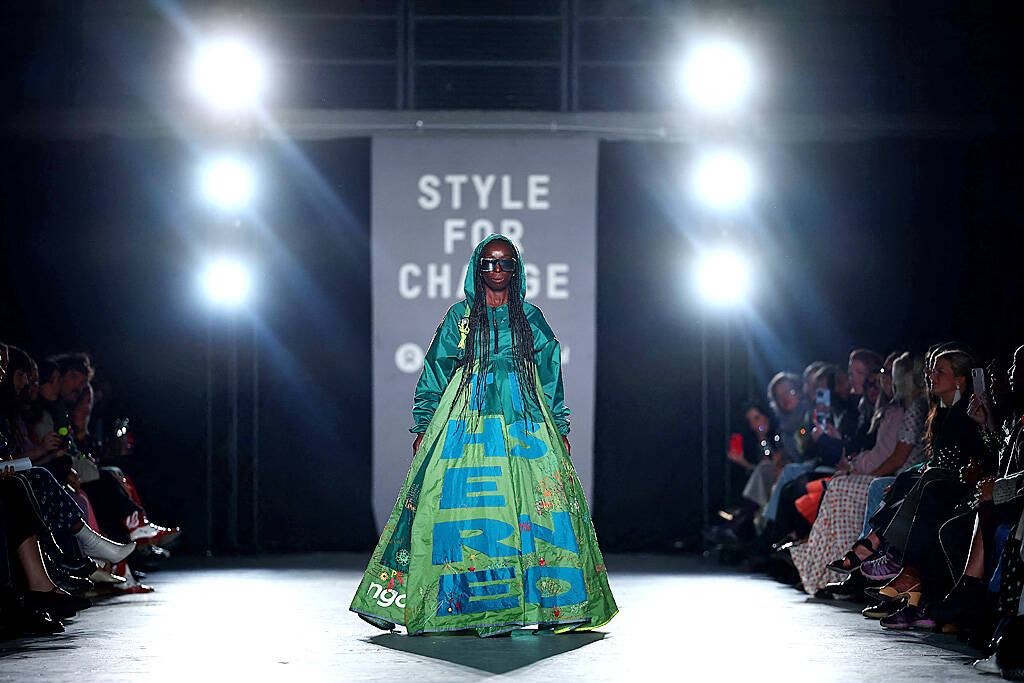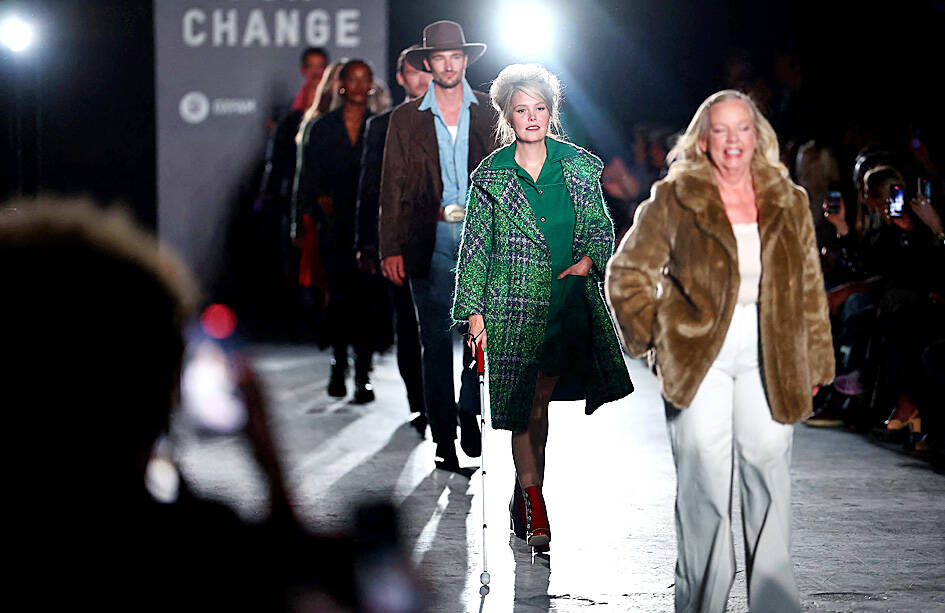In an industrial underground space in central London, models in contrasting period dresses and playful streetwear strutted down a brightly lit London Fashion Week runway.
Unlike most other shows, all the floral dresses, trending workwear and double-denim outfits were secondhand at the event by charity Oxfam and online used clothes retailer Vinted’s “Style for Change.”
Bay Garnett, a sustainable fashion pioneer who picked out the pieces from Oxfam’s warehouses, called the runway “really exciting.”

Photo: AFP
“When we first did this show eight years ago, it was really not like this,” Garnett said backstage, noting the stream of enthusiastic attendees.
Despite the excitement surrounding the Oxfam show alongside another “pre-loved” runway by online auction site eBay Inc, British fashion is struggling with sustainability.
About 44 percent of all British companies overall have put in place a structured climate action plan, according to insurance company Aviva PLC’s “Climate-Ready Index.”

Photo: AFP
By contrast, the fashion world is lagging sorely behind, a situation the Collective Fashion Justice (CFJ) charity said was “an embarrassment.”
A recent CFJ report found that just seven of the 206 members of the British Fashion Council (BFC), which organizes London Fashion Week, had set out targets to reduce their carbon emissions.
Only five of them — or less than 2.5 percent — had goals aligned with the 2016 Paris Agreement to cut global warming, CFJ said.
The UK is the third largest footwear and clothing market in the world, after China and the US, an analysis by the FashionUnited platform showed.
A report released in 2018 by sustainability consultancy Quantis said the sectors account for about 8 percent of planet-heating greenhouse gas emissions.
Luxury fashion giant Burberry Group PLC — a London Fashion Week veteran — is one of the handful of brands publishing scientific targets.
Known for its tartan branding, the fashion house recently raised its emission reduction goals and hopes to be carbon neutral by 2040.
However, BFC chief executive Caroline Rush said that was not enough.
“To set carbon reduction targets, you need a team to be able to measure your targets, understand how to reduce them and then report on them,” she said. “For a small business that’s quite a challenge.”
To help, the BFC has about 50 businesses that would go through its “low carbon transition” program for designers.
Ideally, the program should be extended to help brands monitor and report their carbon reduction plans, advocates said.
Copenhagen Fashion Week has taken its own step to require all brands involved to meet a series of environmental goals.
In the US, reform could come with a “Fashion Act” under consideration by New York authorities, which would legally require businesses to cut emissions and take into account those of their entire supply chains.
“I think a lot of the issue is [that] the fashion industry can try to handball its problems to other industries,” CFJ director Emma Hakansson said.
For example, while there are many discussions on the climate impact of the meat industry, there was not the same pressure on producers of such materials as leather, wool and cashmere, she said.
Yet the latter “are coming from the same supply chains,” which use large quantities of water and emit methane, she added.
There are a number of solutions to make fashion “greener,” some of which would be on display at London Fashion Week, which started on Thursday and ends on Tuesday.
Taiwanese designer Ray Chu (朱柏諺) has created a vegan leather made using recycled tea leaves, while Romanian designer Ancuta Sarca uses recycled materials in her footwear collections.
However, such innovations could struggle to keep up with the scale of emissions and textile waste.
About 300 tonnes of clothes are thrown away every year in the UK, a 2020 British parliament report showed.
Since then, the popularity of fast fashion brands such as Hennes & Mauritz AB’s H&M and Inditex SA’s Zara, and ultra-fast fashion brands like Shein (希音) and PDD Holdings Inc’s (拼多多控股) Temu, has only grown.
Such brands sell cheaply made, mass-manufactured clothes at breakneck speeds, only for them to fall apart or be discarded after being worn a few times.
While many brands are turning to recycled materials, or offering clothing repair or rental services, the long-term solution seems to be to “slow down our habits of consumption in general,” Hakansson said.
To help with this, people could work toward “cultivating a sense of personal style,” she said.
“If you don’t know what you as an individual like, then you’re much more likely to follow these micro trends that are being really pushed on us very hard,” she added.
With greater awareness of the challenges posed by climate change, shopping second-hand has become more popularity, Garnett said.
“The kids have basically got the idea that ... secondhand — it’s a cool way to shop. By finding your own style, a one-off piece, it [becomes] like a style choice,” she said.

PERSISTENT RUMORS: Nvidia’s CEO said the firm is not in talks to sell AI chips to China, but he would welcome a change in US policy barring the activity Nvidia Corp CEO Jensen Huang (黃仁勳) said his company is not in discussions to sell its Blackwell artificial intelligence (AI) chips to Chinese firms, waving off speculation it is trying to engineer a return to the world’s largest semiconductor market. Huang, who arrived in Taiwan yesterday ahead of meetings with longtime partner Taiwan Semiconductor Manufacturing Co (TSMC, 台積電), took the opportunity to clarify recent comments about the US-China AI race. The Nvidia head caused a stir in an interview this week with the Financial Times, in which he was quoted as saying “China will win” the AI race. Huang yesterday said

Nissan Motor Co has agreed to sell its global headquarters in Yokohama for ¥97 billion (US$630 million) to a group sponsored by Taiwanese autoparts maker Minth Group (敏實集團), as the struggling automaker seeks to shore up its financial position. The acquisition is led by a special purchase company managed by KJR Management Ltd, a Japanese real-estate unit of private equity giant KKR & Co, people familiar with the matter said. KJR said it would act as asset manager together with Mizuho Real Estate Management Co. Nissan is undergoing a broad cost-cutting campaign by eliminating jobs and shuttering plants as it grapples

The Chinese government has issued guidance requiring new data center projects that have received any state funds to only use domestically made artificial intelligence (AI) chips, two sources familiar with the matter told Reuters. In recent weeks, Chinese regulatory authorities have ordered such data centers that are less than 30 percent complete to remove all installed foreign chips, or cancel plans to purchase them, while projects in a more advanced stage would be decided on a case-by-case basis, the sources said. The move could represent one of China’s most aggressive steps yet to eliminate foreign technology from its critical infrastructure amid a

MORE WEIGHT: The national weighting was raised in one index while holding steady in two others, while several companies rose or fell in prominence MSCI Inc, a global index provider, has raised Taiwan’s weighting in one of its major indices and left the country’s weighting unchanged in two other indices after a regular index review. In a statement released on Thursday, MSCI said it has upgraded Taiwan’s weighting in the MSCI All-Country World Index by 0.02 percentage points to 2.25 percent, while maintaining the weighting in the MSCI Emerging Markets Index, the most closely watched by foreign institutional investors, at 20.46 percent. Additionally, the index provider has left Taiwan’s weighting in the MSCI All-Country Asia ex-Japan Index unchanged at 23.15 percent. The latest index adjustments are to